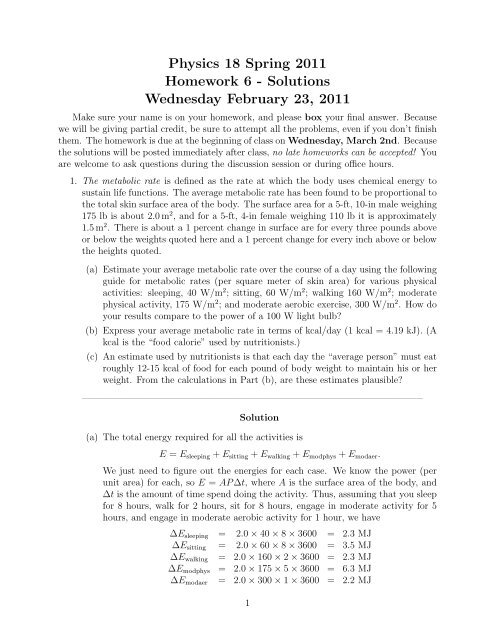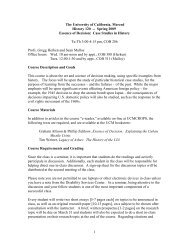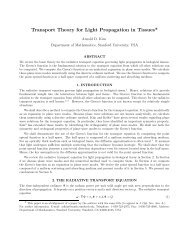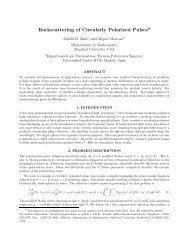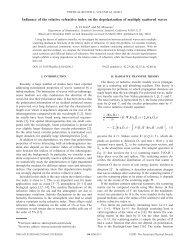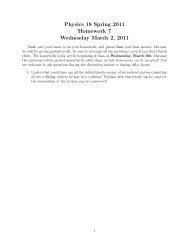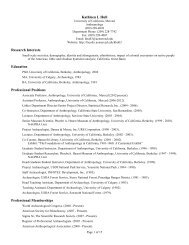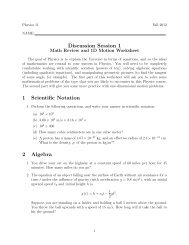Physics 18 Spring 2011 Homework 6 - Solutions ... - Faculty
Physics 18 Spring 2011 Homework 6 - Solutions ... - Faculty
Physics 18 Spring 2011 Homework 6 - Solutions ... - Faculty
You also want an ePaper? Increase the reach of your titles
YUMPU automatically turns print PDFs into web optimized ePapers that Google loves.
<strong>Physics</strong> <strong>18</strong> <strong>Spring</strong> <strong>2011</strong><br />
<strong>Homework</strong> 6 - <strong>Solutions</strong><br />
Wednesday February 23, <strong>2011</strong><br />
Make sure your name is on your homework, and please box your final answer. Because<br />
we will be giving partial credit, be sure to attempt all the problems, even if you don’t finish<br />
them. The homework is due at the beginning of class on Wednesday, March 2nd. Because<br />
the solutions will be posted immediately after class, no late homeworks can be accepted! You<br />
are welcome to ask questions during the discussion session or during office hours.<br />
1. The metabolic rate is defined as the rate at which the body uses chemical energy to<br />
sustain life functions. The average metabolic rate has been found to be proportional to<br />
the total skin surface area of the body. The surface area for a 5-ft, 10-in male weighing<br />
175 lb is about 2.0 m 2 , and for a 5-ft, 4-in female weighing 110 lb it is approximately<br />
1.5 m 2 . There is about a 1 percent change in surface are for every three pounds above<br />
or below the weights quoted here and a 1 percent change for every inch above or below<br />
the heights quoted.<br />
(a) Estimate your average metabolic rate over the course of a day using the following<br />
guide for metabolic rates (per square meter of skin area) for various physical<br />
activities: sleeping, 40 W/m 2 ; sitting, 60 W/m 2 ; walking 160 W/m 2 ; moderate<br />
physical activity, 175 W/m 2 ; and moderate aerobic exercise, 300 W/m 2 . How do<br />
your results compare to the power of a 100 W light bulb?<br />
(b) Express your average metabolic rate in terms of kcal/day (1 kcal = 4.19 kJ). (A<br />
kcal is the “food calorie” used by nutritionists.)<br />
(c) An estimate used by nutritionists is that each day the “average person” must eat<br />
roughly 12-15 kcal of food for each pound of body weight to maintain his or her<br />
weight. From the calculations in Part (b), are these estimates plausible?<br />
————————————————————————————————————<br />
Solution<br />
(a) The total energy required for all the activities is<br />
E = Esleeping + Esitting + Ewalking + Emodphys + Emodaer.<br />
We just need to figure out the energies for each case. We know the power (per<br />
unit area) for each, so E = AP ∆t, where A is the surface area of the body, and<br />
∆t is the amount of time spend doing the activity. Thus, assuming that you sleep<br />
for 8 hours, walk for 2 hours, sit for 8 hours, engage in moderate activity for 5<br />
hours, and engage in moderate aerobic activity for 1 hour, we have<br />
∆Esleeping = 2.0 × 40 × 8 × 3600 = 2.3 MJ<br />
∆Esitting = 2.0 × 60 × 8 × 3600 = 3.5 MJ<br />
∆Ewalking = 2.0 × 160 × 2 × 3600 = 2.3 MJ<br />
∆Emodphys = 2.0 × 175 × 5 × 3600 = 6.3 MJ<br />
∆Emodaer = 2.0 × 300 × 1 × 3600 = 2.2 MJ<br />
1
Thus, altogether, we have ∆E = 16.6 = 17 MJ. This is the energy over the course<br />
of a day. So, the power is P = ∆E 17×106 = = 200 W, which is twice that of a<br />
∆t 24×3600<br />
100 W light bulb.<br />
(b) If 1 kcal is 4190 J, then P = 17×106<br />
4190 day<br />
= 4060 kcal/day.<br />
(c) For a 175 lb person, then 4060/175 = 23 kcal/day/lb, which is higher than these<br />
estimates. However, these calculations are all approximate, based on the average<br />
metabolic rates, etc. So, to be within a factor of 2 is pretty good.<br />
2
2. Assume that your maximum metabolic rate (the maximum rate at which your body<br />
uses its chemical energy) is 1500 W (about 2.7 hp). Assuming a 40 percent efficiency<br />
for the conversion of chemical energy into mechanical energy, estimate the following:<br />
(a) The shortest time you could run up four flights of stairs if each flight is 3.5 m<br />
high,<br />
(b) the shortest time you could climb the Empire State Building (102 stories high)<br />
using your Part (a) result. Comment on the feasibility of you actually achieving<br />
your Part (b) result.<br />
————————————————————————————————————<br />
Solution<br />
The metabolic rate is just the power, P = ˙ W , where, as always, a dot indicates a<br />
derivative with respect to time. So, if the efficiency is ɛ, then the amount of time it<br />
takes to do work ∆W may be found by<br />
ɛP = dW<br />
dt<br />
≈ ∆W<br />
∆t<br />
⇒ ∆t = ∆W<br />
ɛP .<br />
Now, in climbing a height h, the work done is ∆W = mgh. So,<br />
∆t = mgh<br />
ɛP<br />
80 × 10 4<br />
= h =<br />
0.4 × 1500 3 h,<br />
where we have assumed a mass of 80 kg. Now, we can answer the questions.<br />
(a) Here the height of each floor is 3.5 meters, so ∆t = 4 × 4 × 3.5 ≈ 19 seconds.<br />
3<br />
(b) Now, we have to run up 102 flights of stairs, each flight having a height of 3.5<br />
meters, for a total height of 102 × 3.5 = 357 m. This gives a time ∆t = 4 × 357 =<br />
3<br />
476 seconds, or about 8 minutes. It’s extremely unlikely that you could maintain<br />
your maximum metabolic rate at full speed for eight minutes!<br />
3
3. A 3.0 kg block slides along a frictionless<br />
horizontal surface with a speed of 7.0<br />
m/s. After sliding a distance of 2.0 m,<br />
the block makes a smooth transition to<br />
a frictionless ramp inclined at an angle<br />
of 40 ◦ to the horizontal. What distance<br />
along the ramp does the block slide before<br />
coming momentarily to rest?<br />
————————————————————————————————————<br />
Solution<br />
The block starts off with only kinetic energy, KE = 1<br />
2 mv2 . Because the horizontal<br />
surface is frictionless, the block has the same energy at the ramp. After the block<br />
starts sliding up the ramp its kinetic energy changes to potential energy. Eventually,<br />
all of the energy becomes potential energy, and the block reaches a maximum height<br />
h, with P E = mgh. Energy conservation gives the height h = KE v2 = . Now, the<br />
mg 2g<br />
distance along the ramp is given in terms of the height the block reaches as d = h<br />
sin θ ,<br />
where θ = 40 ◦ is the angle of inclination of the ramp. Thus, we finally solve for the<br />
distance<br />
d = v2<br />
2g sin θ =<br />
7 2<br />
2 × 10 × sin (40 ◦ )<br />
4<br />
= 3.8 m.
634<br />
4. A girl of mass m is taking a picnic lunch to her grandmother. She ties a rope of length<br />
R to a tree branch over a creek and starts to swing from rest at a point that is a<br />
distance R/2 lower than the branch. What is the maximum breaking tension for the<br />
rope if it is not to break and drop the girl into the creek?<br />
Chapter 7<br />
46 •• A ————————————————————————————————————<br />
girl of mass m is taking a picnic lunch to her grandmother. She ties a<br />
rope of length R to a tree branch over a creek and starts to swing from rest at a<br />
Solution<br />
point that is a distance R/2 lower than the branch. What is the minimum breaking<br />
tension for the rope if it is not to break and drop the girl into the creek?<br />
The girl is shown to the right. At the bottom<br />
of her swing, we can determine the<br />
tension in the rope using Newton’s laws.<br />
Recalling that the net force is the centripetal<br />
force we have<br />
�<br />
Fy = T − mg = mv2<br />
R ,<br />
Picture the Problem Let the system<br />
consist of the girl and the earth and let<br />
Ug = 0 at the lowest point in the girl’s<br />
swing. We can apply conservation of<br />
mechanical energy to the system to<br />
relate the girl’s speed v to R. The force<br />
diagram shows the forces acting on the<br />
girl at the low point of her swing.<br />
Applying Newton’s 2 nd law to her will<br />
allow us to establish the relationship<br />
between the tension T and her speed.<br />
and so the tension is T = mg + mv2 . Now,<br />
2<br />
we just need to know what the velocity is at<br />
the bottom of the path. This we can determine<br />
from energy conservation. At the top<br />
of the path the girl has a height R/2 above<br />
the bottom. So, she has a potential energy<br />
P E = mgh = mgR<br />
. At the bottom, all<br />
2<br />
this energy is changed into kinetic, 1<br />
2mv2 ,<br />
giving a speed<br />
Apply ∑ radial = radial ma<br />
v = � gR.<br />
F to the girl<br />
So, plugging back into the tension gives<br />
at her lowest point and solve for T:<br />
Apply conservation of mechanical<br />
energy to the system to obtain:<br />
Substituting for Kf and Ui yields:<br />
T = mg + mv2<br />
R<br />
R<br />
T r<br />
1<br />
2<br />
R<br />
g 0 = U<br />
r r<br />
F = mg<br />
2<br />
v<br />
T − mg = m<br />
R<br />
= mg + mgR = 2mg.<br />
and R<br />
2<br />
v<br />
T = mg + m<br />
(1)<br />
R<br />
This is the tension for which all the forces balance. Beyond this, there will be a net<br />
force down, and the rope will break.<br />
W<br />
= ΔK<br />
+ ΔU<br />
= 0<br />
ext<br />
or, because Ki = Uf = 0,<br />
K<br />
f<br />
−U<br />
i<br />
= 0<br />
2<br />
2 R v<br />
mv − mg 0 ⇒ = g<br />
2 R<br />
1<br />
2<br />
=<br />
Substitute for v 2 /R in equation (1) T = mg + mg = 2mg<br />
5<br />
g
5. The 2.0 kg block in the figure slides down a<br />
frictionless curved ramp, starting from rest<br />
at a height of 3.0 m. The block then slides<br />
9.0 m on a rough horizontal surface before<br />
coming to rest.<br />
(a) What is the speed of the block at the<br />
bottom of the ramp?<br />
(b) What is the energy dissipated by the<br />
friction?<br />
(c) What is the coefficient of kinetic friction<br />
between the block and the horizontal<br />
surface?<br />
————————————————————————————————————<br />
Solution<br />
(a) The block starts at a height h, and so has an initial potential energy P E = mgh.<br />
After it has reached the bottom of the ramp, all of its potential energy is now<br />
kinetic, KE = 1<br />
2mv2 . The conservation of energy gives v = √ 2gh. So, the block<br />
is moving at a speed v = √ 2gh = √ 2 × 10 × 3 = 7.7 m/s.<br />
(b) At the bottom of the ramp, before the rough surface, the block only has kinetic<br />
energy, KE = 1<br />
2mv2 = 1<br />
2 × 2 × 7.72 = 60 J. At the end of the surface, the block<br />
isn’t moving, and so it has zero energy. Thus, the energy dissipated by the friction<br />
is Ef = 60 J.<br />
(c) Recalling that the energy dissipated by friction is equal to the work done by<br />
friction, Ef = Wf = µkmgd, where d is the distance the block moves along. So,<br />
µk = Ef<br />
, or mgd<br />
µk = Ef<br />
mgd =<br />
6<br />
60<br />
2 × 10 × 9<br />
= 0.33.
6. A small object of mass m moves in a horizontal circle of radius r on a rough table. It<br />
is attached to a horizontal spring fixed at the center of the circle. The speed of the<br />
object is initially v0. After completing one full trip around the circle, the speed of the<br />
object is 0.5v0.<br />
(a) Find the energy dissipated by friction during that one revolution in terms of m,<br />
v0, and r.<br />
(b) What is the coefficient of kinetic friction?<br />
(c) How many more revolutions will the the object make before coming to rest?<br />
————————————————————————————————————<br />
Solution<br />
(a) Initially, the object was moving at a speed v0, and so it had an initial kinetic<br />
energy KEi = 1<br />
2mv2 0. After running around the circle it is moving at half the<br />
speed, and so has a final kinetic energy KEf = 1<br />
2m (0.5v0) 2 = 1<br />
8mv2 0. So, the<br />
difference in energy is ∆KE = � �<br />
1 1 2 − mv 2 8 0 = 3<br />
8mv2 0, and is the energy lost to<br />
friction. Thus,<br />
∆E = 3<br />
8 mv2 0.<br />
(b) Now this energy is equal to the work done by friction, W = Ff∆ℓ, where Ff =<br />
µkmg is the force due to friction, and ∆ℓ = 2πr is the total distance the object<br />
travels in one orbit. Thus, W = 2πµkmgr = ∆E. Plugging in for ∆E = 3<br />
8 mv2 0<br />
gives<br />
µk = 3v2 0<br />
16πgr .<br />
(c) The object has an energy of only KE = 1<br />
8 mv2 0 left. This energy can do a work<br />
against friction of W = µkmg∆ℓ = 3mv2 0 ∆ℓ. Setting this equal to the kinetic<br />
16πr<br />
energy gives for ∆ℓ<br />
∆ℓ = 1<br />
8 mv2 0 × 16πr<br />
3mv2 =<br />
0<br />
1<br />
(2πr) .<br />
3<br />
So, the object will only make 1/3 of a revolution before stopping.<br />
7
7. If a black hole and a “normal” star orbit each other, gases from the normal star falling<br />
into the black hole can have their temperatures increased by millions of degrees due to<br />
frictional heating. When the gases are heated that much, they begin to radiate light in<br />
the X-ray region of the electromagnetic spectrum (high-energy light photons). Cygnus<br />
X-1, the second strongest known X-ray source in the sky, is thought to be one such<br />
binary system; it radiates at an estimated power of 4 × 10 31 W. If we assume that 1.0<br />
percent of the in-falling mass escapes as X ray energy, at what rate is the black hole<br />
gaining mass?<br />
————————————————————————————————————<br />
Solution<br />
If only one percent of the in-falling mass is released, then the energy released is E =<br />
, then<br />
0.01mc 2 . Since the power is dE<br />
dt<br />
P = dE<br />
dt<br />
= 0.01c2 dm<br />
dt .<br />
So, the rate at which the black hole is gaining mass is just dm,<br />
or dt<br />
Plugging in the values gives<br />
dm<br />
dt<br />
dm<br />
dt<br />
P<br />
= = 100P .<br />
0.01c2 c2 4 × 1031<br />
= 100P = 100 ×<br />
c2 9 × 1016 = 4.4 × 1016 kg/s.<br />
So, the black hole is eating lots of mass every second!<br />
8
8. A large nuclear power plant produces 1000 MW of electrical power by nuclear fission.<br />
(a) By how many kilograms does the mass of the nuclear fuel decrease in one year?<br />
(Assume an efficiency of 33 percent for a nuclear power plant.)<br />
(b) In a coal-burning power plant, each kilogram of coal releases 31 MJ of thermal<br />
energy when burned. How many kilograms of coal are needed each year for a<br />
1000 MW coal-burning power plant? (Assume an efficiency of 38 percent for a<br />
coal-burning power plant.)<br />
————————————————————————————————————<br />
Solution<br />
(a) The plant has a power of P = 1000 MW, which is 10 9 J/s. So, if one year is about<br />
π × 10 7 seconds, then the total energy produced by the plant is<br />
E = 10 9 × π × 10 7 = π × 10 16 J.<br />
Now, Einstein told us that E = mc 2 . So, if the energy is released due to a change<br />
in mass, then ∆m = E<br />
c 2 . If the efficiency is ɛ, then the total change in mass is<br />
Plugging in the numbers gives<br />
∆m = E<br />
=<br />
ɛc2 ∆m = E<br />
.<br />
ɛc2 π × 10 16<br />
0.33 × 9 × 10 1 6<br />
≈ 1.1 kg.<br />
(b) In this case, the coal releases a much smaller amount of energy, at a rate r = 31<br />
MJ. In order to release the same amount of energy as the nuclear plant (π × 10 16<br />
J), at an efficiency of 38%, we would need to burn<br />
∆m = E<br />
ɛr =<br />
π × 10 16<br />
0.38 × 31 × 10 6 ≈ 2.7 × 109 kg.<br />
So, you can see that the nuclear energy requires much less mass!<br />
9
9. In particle physics, the potential energy associated with a pair of quarks bound together<br />
by the strong nuclear force is in one particular theoretical model written as the following<br />
function: U (r) = − (α/r) + kr, where k and α are positive constants, and r is the<br />
distance of separation between the two quarks.<br />
(a) Sketch the general shape of the potential-energy function.<br />
(b) What is a general form for the force each quark exerts on the other?<br />
(c) At the two extremes of very small and very large values of r, what does the force<br />
simplify to?<br />
————————————————————————————————————<br />
(a) The general shape of the potential<br />
energy function is seen in the figure<br />
to the right.<br />
(b) The force is (minus) the slope of the<br />
potential energy, so<br />
F = − d<br />
dr U(r).<br />
Working out the derivatives gives<br />
Solution<br />
-5<br />
-10<br />
-15<br />
-20<br />
-25<br />
F (r) = − d<br />
�<br />
−<br />
dr<br />
α<br />
�<br />
+ kr<br />
r<br />
Potential energy<br />
15<br />
10<br />
5<br />
Potential Energy Graph<br />
0<br />
0 0.5 1 1.5 2 2.5<br />
= − α<br />
− k.<br />
r2 (c) For very small values of r, the first term in the force becomes important, and so<br />
we get a large attractive force<br />
F → − α<br />
r 2 for r → 0,<br />
while for very big values of r, the first term dies away, and so the force becomes<br />
a constant attractive force<br />
F → −k for r → ∞.<br />
10<br />
Distance
10. In one model of a person jogging, the energy expended is assumed to go into accelerating<br />
and decelerating the feet and the lower portions of the legs. If the jogging speed is v,<br />
then the maximum speed of the foot and lower leg is about 2v. (From the moment<br />
a foot leaves the ground, to the moment it next contacts the ground, the foot travels<br />
nearly twice as far as the torso, so it must be going, on average, nearly twice as fast as<br />
the torso.) If the mass of the foot and lower portion of a leg is m, the energy needed to<br />
accelerate the foot and lower portion of a leg from rest to speed 2v is 1<br />
2 m (2v)2 = 2mv 2 ,<br />
and the same energy is needed to decelerate this mass back to rest for the next stride.<br />
Assume that the mass of the foot and lower portion of a man’s leg is 5.0 kg and that he<br />
jogs at a speed of 3.0 m/s with 1.0 m between one footfall and the next. The energy he<br />
must provide to each leg in each 2.0 m of travel is 2mv 2 , so the energy he must provide<br />
to both legs during each second of jogging is 6mv 2 . Calculate the rate of the man’s<br />
energy expenditure using this model, assuming that his muscles have an efficiency of<br />
20 percent.<br />
————————————————————————————————————<br />
Solution<br />
The rate of the man’s energy expenditure is just the power, which is P = ∆E . Because<br />
∆t<br />
his muscles have an efficiency of only 20%, much of the energy is wasted, and so he has<br />
to work a lot harder to provide the energy to run. Thus, if the power being expended<br />
to run is P , then he has to expend power at a rate P/0.2 = 5P , in order to get out a<br />
power P . So, he has to expend energy<br />
P = 5 ∆E<br />
∆t<br />
= 56mv2<br />
∆t = 30mv2 ,<br />
where we have taken ∆t = 1 second, since we’re told that the energy is 6mv 2 per<br />
second. Plugging in values gives, taking m = 10 kg for both legs,<br />
P = 30mv 2 = 30 × 10 × 3 2 = 30 × 10 × 9 = 2700 W.<br />
11


